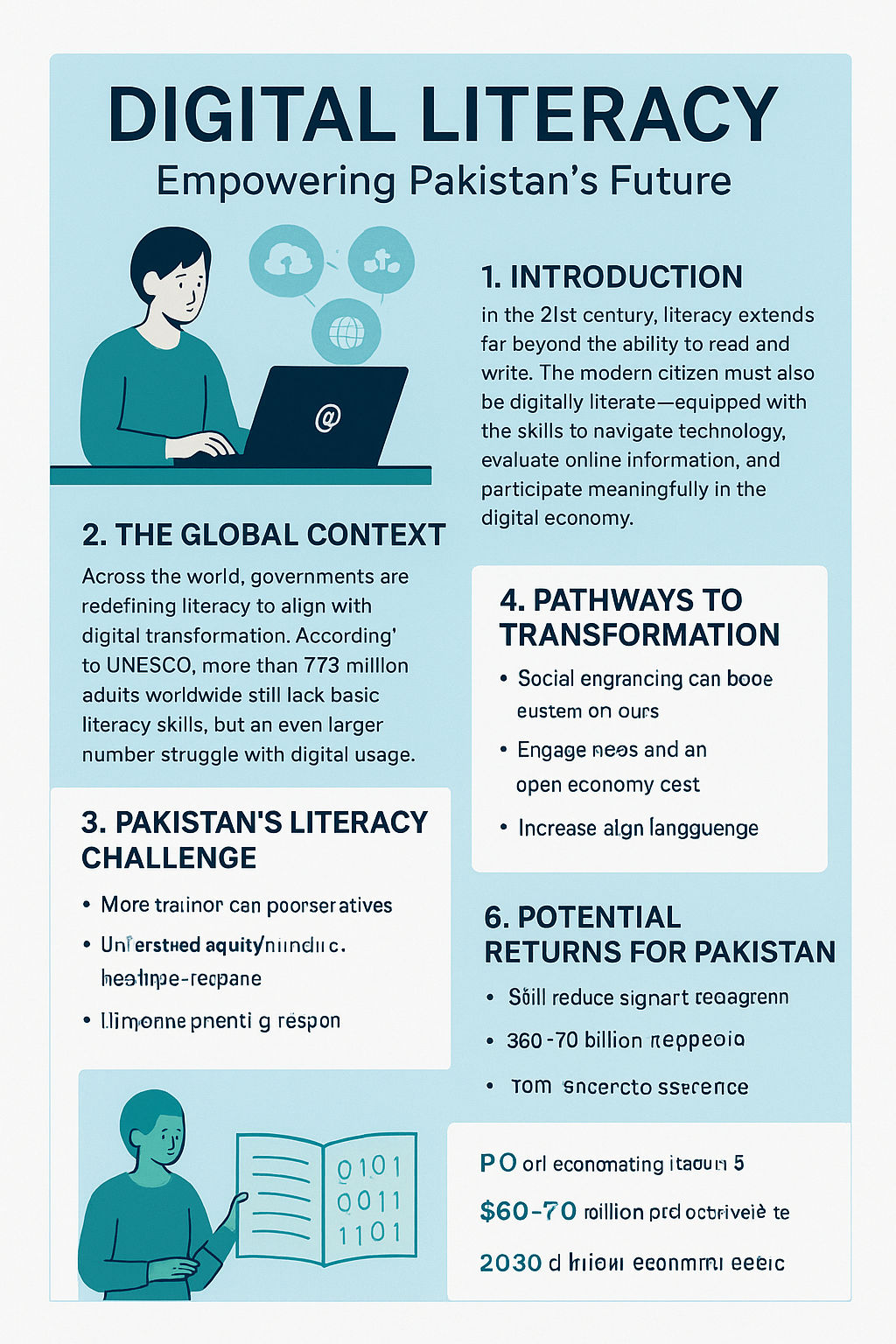Digital Literacy: Empowering Pakistan’s Future
1. Introduction
In the 21st century, literacy extends far beyond the ability to read and write. The modern citizen must also be digitally literate — equipped with the skills to navigate technology, evaluate online information, and participate meaningfully in the digital economy. Without such competencies, individuals risk exclusion from jobs, education, healthcare, and civic participation.
For countries like Pakistan, where traditional illiteracy still persists at alarming levels, the challenge is two-fold: closing the gap in basic literacy while simultaneously preparing the population for the demands of the digital era.
2. The Global Context
Across the world, governments are redefining literacy to align with digital transformation. According to UNESCO, more than 773 million adults worldwide still lack basic literacy skills, but an even larger number struggle with digital usage. In developed economies, over 90% of jobs require at least basic digital skills such as email, online communication, or using digital financial services. This trend indicates that digital literacy has become as essential as traditional literacy once was during the industrial age.
3. Pakistan’s Literacy Challenge
-
Traditional Illiteracy: Pakistan’s adult illiteracy rate remains around 40%, with women and rural populations disproportionately affected.
-
Digital Divide: Smartphone ownership is growing, yet only about 52% of the population has regular internet access. Connectivity costs remain high compared to household incomes, particularly in rural areas.
-
Skill Gap: Among those with internet access, digital skills are often limited to social media use. Only a small proportion of users can effectively engage in online learning, digital financial services, or e-governance platforms.
This means that while Pakistanis are entering the digital space, most remain passive consumers rather than active participants in the digital economy.
4. Lessons from the Pandemic
The COVID-19 pandemic starkly revealed Pakistan’s digital gaps. Elite private schools swiftly transitioned to online classes, while millions of students in government schools were left without access due to lack of devices, poor connectivity, or low teacher training in digital methods. This digital divide not only disrupted learning for millions of children but also widened socio-economic inequalities.
5. Shortcomings in Current Approaches
Government initiatives such as the introduction of “smart classrooms,” digital portals, and online registration platforms are steps in the right direction, but they fall short for several reasons:
-
Teachers lack training to effectively use technology.
-
Internet access remains prohibitively expensive for low-income families.
-
Urban-rural disparities mean digital projects rarely scale to underserved areas.
-
Symbolic projects often replace long-term planning and structural reforms.
6. Why Digital Literacy Matters
A digitally literate population is crucial for:
-
Economic Growth: Digital skills enable participation in freelancing, IT exports, and e-commerce. Pakistan already has one of the largest freelancing communities globally, but it needs broader training to scale up.
-
Education: Digital literacy allows students to access online resources, virtual libraries, and global learning platforms.
-
Governance: Citizens can engage with e-services, online tax systems, and government portals, reducing corruption and inefficiency.
-
Social Inclusion: Women, marginalized groups, and rural communities gain opportunities through online platforms and remote work.
7. Pathways to Transformation
For Pakistan to truly embrace digital literacy, systemic changes are required:
-
Infrastructure Development
-
Expand broadband coverage to rural and remote areas.
-
Make internet access affordable through subsidies and public-private partnerships.
-
-
Teacher and Student Training
-
Incorporate digital literacy into national curricula from the primary level.
-
Provide large-scale digital training programs for teachers.
-
-
Community Access Centers
-
Establish digital hubs in rural areas to provide internet access, training, and resources.
-
-
Gender Inclusion
-
Launch initiatives specifically designed to improve women’s access to devices, connectivity, and digital skills training.
-
-
Sustained Policy Commitment
-
Move beyond symbolic projects and commit to long-term, funded national digital literacy programs.
-
8. Potential Returns for Pakistan
-
Economic impact: By equipping the population with digital skills, Pakistan could potentially add $60–70 billion to its GDP through IT exports, freelancing, and e-commerce by 2030.
-
Educational equity: Digital platforms could provide millions of children with access to resources otherwise unavailable in their communities.
-
Democratic participation: A digitally connected citizenry is better able to engage in national debates, hold governments accountable, and exercise civic rights.
Vocabulary Table
| Term | Definition / Significance |
|---|---|
| Digital literacy | Competency to use, evaluate, and create information through digital platforms. |
| Digital fluency | Advanced ability to navigate complex digital tools and systems. |
| Digital divide | The gap between those with access to digital tools and those without. |
| Smart classrooms | Classrooms equipped with digital teaching tools; effectiveness depends on proper training. |
| E-governance | Delivery of government services and engagement through digital platforms. |
| Capacity building | Training and equipping individuals or institutions to adopt digital tools effectively. |
| Digital economy | Economic activity driven by digital technologies such as e-commerce and IT exports. |
| Social inclusion | Ensuring marginalized groups have equal access to digital resources and opportunities. |
| Digital infrastructure | Core technologies — broadband, devices, servers — enabling connectivity. |
| Gender digital divide | Disparities in digital access and skills between men and women. |
9. Conclusion
Digital literacy is no longer optional. For Pakistan, the stakes are particularly high: with nearly half the population unable to read and write, and a significant portion digitally excluded, the country risks falling behind in an increasingly competitive global economy. Policymakers, educators, and civil society must recognize that bridging the digital divide is not just about access to technology — it is about preparing citizens for the future.
If Pakistan commits to long-term investment in infrastructure, training, and inclusivity, digital literacy can become a powerful driver of economic growth, educational equity, and social transformation. Without it, millions risk being locked out of opportunities that define the modern world.


